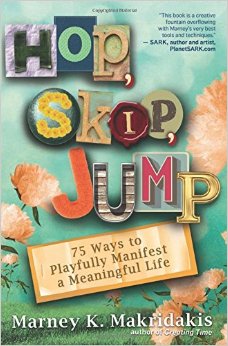
How Does Play Factor into the Creative Process?
 As a certified creativity coach and life purpose alchemist, I work with divinely-inspired artists and writers on their creative process, helping them sort through their many ideas so they can choose a project that’s fully aligned with their authentic vision.
As a certified creativity coach and life purpose alchemist, I work with divinely-inspired artists and writers on their creative process, helping them sort through their many ideas so they can choose a project that’s fully aligned with their authentic vision.
A lot goes into the creative process, from idea to planning to implementation to completion. And while it can be an exciting journey, it can sometimes feel like a lot of hard work.
This is where play comes into the mix. When we can make the process fun, it becomes joyful – from beginning to end.
So how can we take a more playful approach toward productivity and creative manifestation?
Today, I’ve asked my good friend and colleague Marney Makridakis, author of two best-selling books on creativity, to join me for a dialogue about play – and how it factors into the creative process. Her latest book, HOP, SKIP, JUMP: 75 Ways to Playfully Manifest a Meaningful Life – has just been released by New World Library and highlights three creative approaches to productivity.
Here’s what Marney has to say about play – and why it’s important to the creative process.
*********
Your book is about blending play and productivity. What does that mean?
It’s simple: when we are having fun, we get more done. Whatever you want to manifest in your life – a new job, a dream vacation, improved health or the ideal chai latte – productivity and success are really all about momentum. Though we think of productivity and play as polar opposites, when they come together, each becomes more vibrant. When we allow ourselves to feel playful, we connect to a sense of fun and flow, and what once felt like work becomes much easier. And when we bring a purpose to our play – when we consciously call upon play to serve a purpose in our daily lives – then we connect to our deeper sense of meaning. I see play and productivity as two happy handfuls of Play-Doh, beautifully blending to reveal the brand-new colors of a meaningful life.
Why is play so often undervalued in our culture?
Studies show that kids play less today than they ever have, and it’s detrimental to their health and development. As the demands of our achievement-oriented society are weighing on our kids, the pressure seems to be hitting adults even harder. Even family vacations, one of our most special times of play, are at an all-time low. In our fast-paced, results-driven society, when we do in fact have the rare opportunity to step away from the oppressive pressure, we are so exhausted that we tune out or turn to numbing activities on electronic gadgets, rather than meaningful experiences of play that truly bring us joy. Our adrenaline is either charged up or checked out. And play – which exists in the sweet spot in between – is completely overlooked and undervalued.
Why did you want to write a book about play?
About 10 years ago, I was watching Cirque du Soleil – the company that reinvented the art of the traditional circus – and I thought to myself, “Now this is how I want to feel all the time.” visual intrigue, bold visual paradox, abstract acrobatics, and whimsical flights of fancy…these are all the things that make my soul feel like its settling inside me. I decided to imagine that anytime something felt like hard work, I could re-imagine it taking place in a Cirque du Soleil setting. I called this exercise Work du Soleil, and it became my personal work ethic: to imagine a world where work feels like play, and live there as much as possible. I think all people have the potential to create their own version of this story: to find what opens their portal to play and use it to be help them manifest whatever they want. I wanted to offer a collection of ideas to help readers start seeing their own lives, tasks, and goals through the perspective of play. It’s basically an idea book, filled with the techniques and tools that have been most effective for me and my clients.
What is play, exactly? How does someone start to approach the idea of play?
Play can be much more than simply filling the open spaces between work and daily responsibilities. Animals and children have a deep instinct to play; nobody needs to show them how to do it! But most adults could use a bit of training to connect to playful activities that intensify joy and reduce stress. It’s important to clarify that there is no “right way” to play, and we all do it differently. It could playing an old-fashioned game of jacks, writing a poem in the middle of a work day, wearing an outrageous pair of socks, or taking an adventure walk before the sun rises. Play is a not an activity, it is a state of mind; play is the portal to presence. Play is the way you touch and amplify the enchantment of being human.
Is success really as easy as Hop, Skip, Jump?
Many of my clients are creative entrepreneurs, and I often advise them that if they are not smiling when they say the name of their business or program, it’s probably not the right name! Hop, Skip, and Jump are words that are fun to say – and they imply a sense of ease and close proximity. When we’re having fun, any task is definitely easier! But there’s more to Hop, Skip, and Jump than just a sense of ease. Play is most effective when it’s used with an understanding of the manifestation process. So Hop, Skip, and Jump represent three phases of successful manifestation: Hop focuses on dreaming, brainstorming, planning, visioning; Skip focuses on experimenting, dabbling, and trying new things; Jump focuses on conscious action and completion.
Which phase is most important – Hop, Skip, or Jump?
They are all so awesome and potent, and one is not better than the other! When approaching goals from a whole-brained point of view, Hop, Skip, and Jump represent three distinct energies that work together harmoniously. Each phase serves its own purpose, and also has its own advantages and potential risks. Most of us are most comfortable in one of the phases, and thus unknowingly miss some crucial parts of the manifestation process. For example, I am most comfortable in the Jump phase, so my natural inclination is to spend very little time in the Hop and Skip stages. However, I really make the most progress when I accentuate the aspects of me that are naturally strong and gently activate the less naturally prominent ones. With 25 ideas for each phase, the book has lots of possibilities for fun and fulfillment across the entire manifestation process, both in and outside of your comfort zone.
*********
 Marney K. Makridakis is the founder of Artella Land, the groundbreaking online community for artists, writers, and creative individuals. Since 2002, Artella has been a playland for creativity, full of innovative services that embrace the uniqueness of individuals, catalyzing unawakened inklings and inspirations to come alive and passionately thrive. Marney is a widely known voice in the creativity movement, frequently requested for interviews, guest columns, workshops, and speeches. To learn more about her latest book, HOP, SKIP, JUMP: 75 Ways to Playfully Manifest a Meaningful Life – and to take a fun quiz to find out your creative manifestation style, please visit: Hop, Skip, Jump
Marney K. Makridakis is the founder of Artella Land, the groundbreaking online community for artists, writers, and creative individuals. Since 2002, Artella has been a playland for creativity, full of innovative services that embrace the uniqueness of individuals, catalyzing unawakened inklings and inspirations to come alive and passionately thrive. Marney is a widely known voice in the creativity movement, frequently requested for interviews, guest columns, workshops, and speeches. To learn more about her latest book, HOP, SKIP, JUMP: 75 Ways to Playfully Manifest a Meaningful Life – and to take a fun quiz to find out your creative manifestation style, please visit: Hop, Skip, Jump


7 Comments
Christina Kelly
I love the look of this book! It sounds like it’s right up my alley. I just took the quiz and I’m in the Skip category.
Sangita
Hi Tina,
Thank you for sharing, I love playing. I agree that just like Happiness, Play is also the state of mind. I ordered the book. I will refer that in one of the modules that 3 of us teachers are co creating a 7 module course for Family Harmony.
Love and Light
Sangita
Bonnie Nussbaum
This looks like a wonderful book! Gonna order it. I also think that the amount of time people, kids included, spend in front of screens inhibits the natural urge to play. I’m over 50 and I remember my mother often saying, “Turn off that TV and get outside to play!”
Veronica
Wonderful article Tina! I just finished coloring a vibrant butterfly I began a few days ago. I sat down with a template and went to work with colored pencils. It was wonderful and meditative! I purchased an adult coloring book for my sister and daughter last year which they both love. Both are somewhat anxious people and this settles them down to sit, color and admire a finished product of play! You entice me with how you must do your workshops as well – bravo – just love it!
Jill Greinke
Looks like a great book! As adults playing really is important in our lives. We don’t play enough, we need take the time in our busy lives, just to play.
Kailean
What a great line: “Play is the way you touch and amplify the enchantment of being human.” Fabulous blog post to help integrate play and productivity. It sure resonates with me, as I know that I am much more productive when I am at ease and enjoying what I am doing. I want life to be fun, yet I also want to be responsible and productive. It’s too bad we are all so trained that these are separate constructs. Time to change that old message.
Teena
Tina – This is such an inspiring, creative and playful interview. I agree that if we can invite play and make the process FUN then the process becomes joyful – from beginning to end!
Teena
http://www.coupletherapyconnection.com